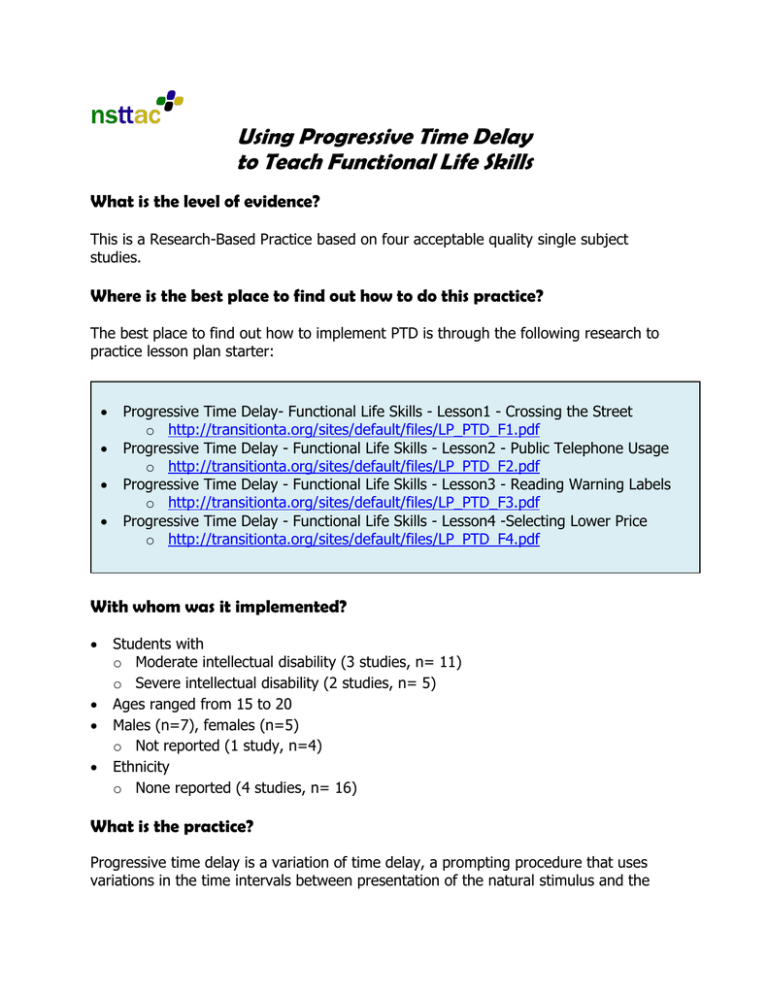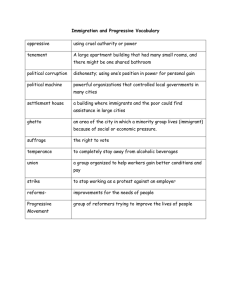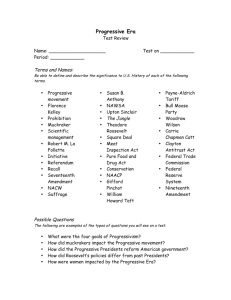Using Progressive Time Delay to Teach Functional Life Skills
advertisement

Using Progressive Time Delay to Teach Functional Life Skills What is the level of evidence? This is a Research-Based Practice based on four acceptable quality single subject studies. Where is the best place to find out how to do this practice? The best place to find out how to implement PTD is through the following research to practice lesson plan starter: Progressive Time Delay- Functional Life Skills - Lesson1 - Crossing the Street o http://transitionta.org/sites/default/files/LP_PTD_F1.pdf Progressive Time Delay - Functional Life Skills - Lesson2 - Public Telephone Usage o http://transitionta.org/sites/default/files/LP_PTD_F2.pdf Progressive Time Delay - Functional Life Skills - Lesson3 - Reading Warning Labels o http://transitionta.org/sites/default/files/LP_PTD_F3.pdf Progressive Time Delay - Functional Life Skills - Lesson4 -Selecting Lower Price o http://transitionta.org/sites/default/files/LP_PTD_F4.pdf With whom was it implemented? Students with o Moderate intellectual disability (3 studies, n= 11) o Severe intellectual disability (2 studies, n= 5) Ages ranged from 15 to 20 Males (n=7), females (n=5) o Not reported (1 study, n=4) Ethnicity o None reported (4 studies, n= 16) What is the practice? Progressive time delay is a variation of time delay, a prompting procedure that uses variations in the time intervals between presentation of the natural stimulus and the response prompt. Time delay transfers stimulus control from a prompt to the natural stimulus by delaying the presentation of the prompt following the presentation of the natural stimulus. Progressive time delay is implemented by presenting a trial with a 0second delay between the presentation of the natural stimulus and the response prompt and then gradually and systematically extending the time delay, often in one second intervals (e.g., 0 sec to 2 sec to 3 sec; Cooper, Heron, & Heward, 2007). In the studies used to establish progressive time delay as an evidence-based practice for teaching functional life skills the controlling prompts were: physical (Collins & Stinson, 1994-1995) verbal (Collins, Stinson, & Land, 1993) verbal paired with a gestural(McDonnell, 1987) verbal paired with model (Sandknop, Schuster, Wolery, & Cross, 1993) How has the practice been implemented? Progressive time delay paired with verbal prompts has been used to teach purchasing (McDonnell, 1987) Progressive time delay paired with observational learning has been used to teach reading warning labels (Collins & Stinson, 1994-1995) Progressive time delay paired with both simulation and in vivo training has been used to teach street crossing and using a pay telephone (Collins, Stinson, & Land, 1993) Progressive time delay paired with a response prompt (i.e., number line) has been used to teach price comparison (Sandknop, Schuster, Wolery, & Cross, 1993) Where has it been implemented? Community (3 studies) Students’ home (1 study) How does this practice relate to Indicator 13? Indicator 13 Checklist Item #3: Teaching purchasing skills may reflect results of transition assessment information Indicator 13 Checklist Item # 4: Teaching purchasing may be a transition service designated in an IEP that will enable a student to meet his or her postsecondary independent living goal(s) Indicator 13 Checklist Item #6: Teaching purchasing may be part of an annual IEP goal that supports a student’s postsecondary independent living goal(s) How does this practice relate to Common Core Standards? Vocabulary Acquisition and Use (Anchor Standards for Language, Grades 9-12) o Acquire and use accurately a range of general academic and domain specific words and phrases sufficient for reading, writing, speaking and listening at the college and career readiness level Apply and extend previous understandings of numbers to the system of rational numbers (The Number System, Grade 6) o Understand a rational number as a point on the number line. Extend number line diagrams and coordinate axes familiar from previous grades to represent points on the line and in the plane with negative number coordinates o Understand that positive and negative numbers are used together to describe quantities having opposite directions and values (e.g., temperature above/below zero, elevation above/below sea level, credits/debits, positive/negative electric charge); use positive and negative numbers to represent quantities in real-world contexts, explaining the meaning of 0 in each situation How does this practice relate to the State’s Career Cluster Initiative: Essential Knowledge and Skills? Demonstrate language arts knowledge and skills required to pursue the full range of post-secondary education and career opportunities (Academic Foundations) o Comprehend key elements of oral and written information. Demonstrate mathematics knowledge and skills required to pursue the full range of post-secondary education and career opportunities (Academic Foundations) o Demonstrate knowledge of basic arithmetic operations such as: addition, subtraction, multiplication, and division o Demonstrate use of relational expressions such as: equal to, not equal, greater than, less than, etc. References used to establish this evidence base: Collins, B.C., & Stinson, D.M. (1994-1995). Teaching generalized reading of product warning labels to adolescents with mental disabilities through the use of key words. Exceptionality, 5, 163-181. Collins, B.C., Stinson, D.M., & Land, L. (1993). A comparison of in vivo and simulation prior to in vio instruction in teaching generalized safety skills. Education and Training in Mental Retardation, 28, 128-142. McDonnell, J. (1987). The effects of time delay and increasing prompt hierarch strategies on the acquisition of purchasing skills by students with severe handicaps. The Association for Persons with Severe Handicaps, 12, 227-236. Sandknop, P.A., Schuster, J.W., Wolery, M., & Cross, D.P. (1992). The use of an adaptive device to teach students with moderate mental retardation to select lower priced grocery items. Education and Training in Mental Retardation, 27, 219-229.



